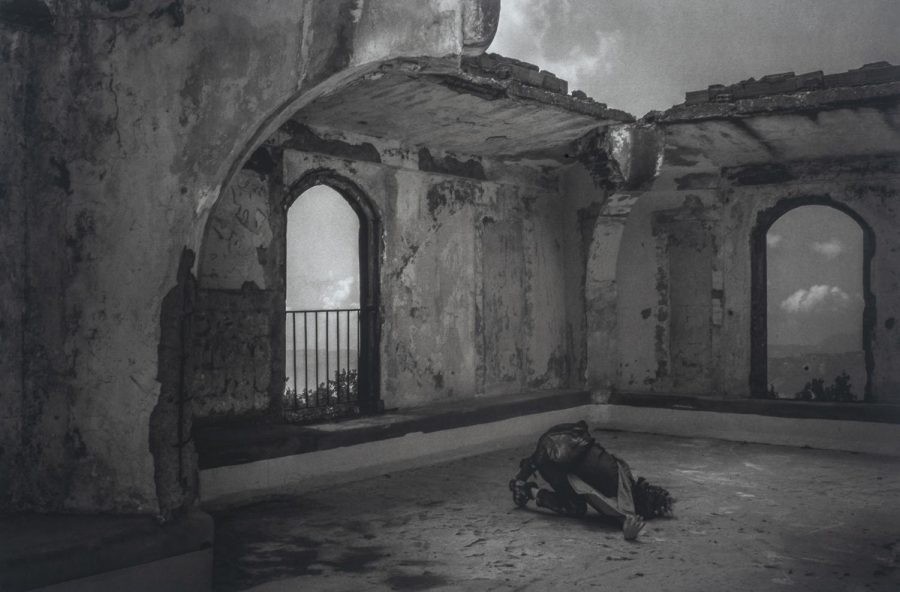The edges of memory and the depths of home with Andrea Shaker
December 5, 2019
“I returned to remember but everything around me was about forgetting.”
This was the opening line of a poem that photographer Andrea Shaker wrote to accompany her art installation “on bayt.” Her installation, a collection of photography and video images, is the result of a four month trip she took to her family’s homeland in Lebanon.
Before 2017, Shaker had never been to Lebanon. However, she still felt a strong connection to the country. Much of her extended family had emigrated from Lebanon to the U.S. in the early 20th century, and she grew up listening to the adults tell stories about the homeland or sharing concerns about the war and the people they left behind.
“As a young girl, these stories grew into images in my mind, and these images transformed into imagined memories,” Shaker wrote in her artist statement. “While this was my first time in Lebanon, on many levels it felt like a return, a return to a home that was always and never mine.”
The Arabic word ‘bayt’ refers to a house, including the people and atmosphere inside of it. Shaker feels this word encompasses her artwork, which she says looks “at how home is not defined by a physical structure, but by much more.”
With this definition of home in mind, Shaker’s photographs explore the relationship between buildings and bodies. Shaker worked alongside two dancers during her trip to Lebanon, who feature in many of her photographs. Although they represent a more universal human presence in the photos, each dancer has a personal story that Shaker took into account.
“My [photography] process [includes] conversations, and asking ‘how might you move through this space?’” Shaker said.
Minnesota-based Leila Awadallah poses in many of Shaker’s photographs, including in an image of Awadallah’s hands clinging to the crevices of a wall in Lebanon. The vision for this image came about after conversations in which Awadallah shared her Palestinian background and the symbolism of walls in Palenstine.
Shaker met Sophia Moussa, a Lebanese dancer, by chance in a coffee shop during her trip, and featured her in many of her images as well. Moussa was in Lebanon during the 2006 war, and has a scar on her leg from an explosion. Shaker included the scar in some of the images to show the similarities between the scars on bodies and on structures, as some of the buildings in Lebanon were bombed out.
“[I was] exploring the notion of wounds and scars, whether it be from war or migration, as memories held in the body that become part of our physiology,” Shaker said.
Much of Shaker’s work focuses heavily on her own memories, those of her family and of Lebanon as a whole. Shaker uses both still photography and continuous, silent film to capture the nuance of memories forgotten, misremembered or recreated.
“I’ve always been interested in the relationship between the moving image and the still image, and how memory functions in that regard,” Shaker said.
“The still image remembers one moment, but forgets everything else. The moving image anticipates what’s going to happen, while at the same time erasing and forgetting what came before it.”
As much as Shaker’s trip to Lebanon was for work, it was deeply personal as well. With the help of the mayor of Ma’asser el Chouf, her family’s village, Shaker was able to identify which house was once ‘bayt chakar,’ or ‘house of Shaker.’
“The mayor of the village that my family is from met me in Beirut, and we went from house to house to meet folks from the village who might know which one was my family home, and all of a sudden, the light bulb went off and he said ‘I know which house is yours,’” Shaker recalled.
Shaker recounts the moment she walked into ‘bayt chakar,’ which showed physical proof of abandonment.
“Oh god, it was so intense,” she said. “The structure was beautiful in its own way, but to know it was where my grandparents were, it was an emotional experience.”
Shaker spent time in Ma’asser el Chouf, taking photos, meeting distant family members and exploring the village she had always heard about in stories.
“People would say, ‘you know, you look like a Shaker.’ There was something about knowing that my family had a history there, and I felt a connection,” Shaker said. “I found that being in Lebanon, I understood more [about my family]. I felt at home there.”
Shaker’s images define home as haunting, emotionally charged and forever complicated. “on bayt” pays homage to painful memories of war and loss while also capturing the new memories born of Shaker’s homecoming.
“on bayt” is on display at the Marsden/Gustafson Gallery at FilmNorth through Jan. 23.













